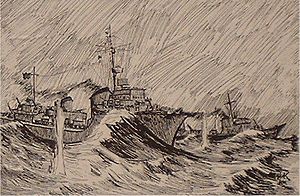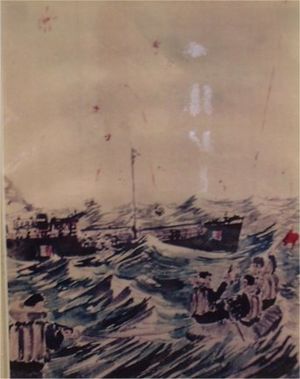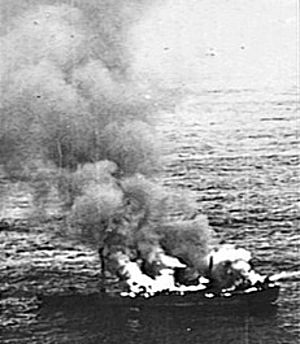MV Kerlogue facts for kids
class="infobox " style="float: right; clear: right; width: 315px; border-spacing: 2px; text-align: left; font-size: 90%;"
| colspan="2" style="text-align: center; font-size: 90%; line-height: 1.5em;" | ![MV Kerlogue passing through Dalkey sound [1]](/images/8/8f/Kerlogue_Dalkey.jpg)
|}
A sketch of the rescue drawn by Hans Helmut Karsch, while interned in the Curragh. National Maritime Museum of Ireland
The MV Kerlogue was a small Irish ship that became famous during World War II. She is a great example of how neutral Irish ships acted during the war. Even though she was small, the Kerlogue was attacked by both sides. She also bravely rescued people from both sides of the conflict.
The Kerlogue almost sank because of a German mine. She was also shot at by planes from the Royal Air Force. Despite these dangers, she rescued the crew of a British ship called the Wild Rose. Later, she saved survivors from a German destroyer and its escort ships. These German survivors were brought to Ireland and kept safe until the war ended.
Contents
| History | |
|---|---|
| Name | Kerlogue |
| Owner | Wexford Steamship Company |
| Port of registry | Wexford |
| Builder | Rotterdam |
| Launched | 1938 |
| Completed | February 1938 |
| Fate | Wrecked off Tromsø in 1960 |
| General characteristics | |
| Tonnage | 335 GRT |
| Length | 142 ft (43 m) |
| Deck clearance | 1 ft (0.30 m) |
| Crew | 11 |
- Building the Kerlogue
- Rescuing the Wild Rose
- Attack by the RAF
- Rescue in the Bay of Biscay
- After the War
- See also
Ireland's Shipping Needs
Coastal Trading Ships
After the Irish War of Independence (1919–1921) and the Irish Civil War (1921–1922), travel within Ireland was very hard. Roads were not in good condition. Ireland also did not have many railways. Because of this, it was often faster and cheaper to move goods by sea around the coast.
Ships that did this were called coasters. The MV Kerlogue was one of these important coastal trading vessels.
World War II Challenges
When World War II began, Ireland did not have enough ships. The number of Irish ships had dropped a lot. Most of Ireland's international trade was carried on British ships. But when the war started, these ships were no longer available for Ireland.
Also, the United States told its ships not to enter the "war zone." This meant that goods for Ireland were often dropped off in Portugal. So, small ships like the Kerlogue had to make long journeys they were not built for.
Usually, the Kerlogue would carry Irish farm products to Britain. There, she would get fuel and take British goods to Spain or Portugal. Often, this was coal for power stations in Lisbon. She would then pick up American goods, like fertilizer or wheat, and bring them back to Ireland.
Building the Kerlogue
The MV Kerlogue was built in Rotterdam, Netherlands. She was finished in February 1938, just before World War II started. She was about 142 feet (43 m) long. Her size was measured at 335 gross register tons.
Her freeboard was only 1 foot (0.30 m). This means the deck was only about one foot above the water! She had a crew of eleven people. Like other Irish ships, the word EIRE and the Irish flag were painted big on her sides and deck. This showed everyone she was a neutral Irish ship.
Rescuing the Wild Rose
On April 2, 1941, a British group of ships was attacked by German planes. This happened near Tuskar Rock, Ireland. The crew of the Kerlogue saw distress signals. They quickly changed course to help.
They found a burning oil tanker with no survivors. They also found a damaged coal ship, the Wild Rose from Liverpool. The Wild Rose was slowly sinking. She had no power, and her lifeboats were destroyed.
The Kerlogue bravely took the much larger Wild Rose in tow. They rescued all thirteen crew members. To stop the Wild Rose from sinking, she was pulled onto Rosslare Strand beach. The Kerlogue was given £4,000 for this rescue. The Wild Rose was later fixed in the Liffey dockyard.
Later, on October 7, 1941, the Kerlogue hit a mine. This happened in Cardigan Bay while she was sailing from Swansea to Wexford.
Attack by the RAF
On October 23, 1943, the Kerlogue was about 130 miles (210 km) south of Ireland. She was carrying coal from Port Talbot to Lisbon. First, an Australian Sunderland flying boat circled her.
Three hours later, two unknown planes attacked her. These were later found to be Mosquito fighter planes. They belonged to No. 307 Polish Night Fighter Squadron. For twenty minutes, they repeatedly dived and fired their cannons at the Kerlogue.
Another Sunderland plane came by later. The Kerlogue used a signal lamp to ask for help and medical aid. The Sunderland replied that it could not help.
The damaged Kerlogue slowly made her way back to Cobh. When her coal cargo was unloaded, British shell pieces were found. It was the coal that saved the Kerlogue. Without it, the shells would have gone right through her hull.
The British government later looked into the attack. They knew the Kerlogue was a neutral ship. They also knew she was in the area. The British decided that the Polish pilots should not have attacked. The British government made special payments to the injured crew members.
Captain Desmond Fortune was badly hurt and could not walk without help again. Captain Thomas Donohue took over as captain. Captain Donohue had also been through a lot. His previous ship was bombed by German planes. He had spent eight hours in a lifeboat in the middle of the Atlantic Ocean after his ship was sunk by a German submarine.
Rescue in the Bay of Biscay

On December 29, 1943, after repairs, the Kerlogue was 360 miles (580 km) south of Fastnet Rock. She was sailing from Lisbon to Dublin with a cargo of oranges. A German plane circled her, signaling "SOS" and flying southeast.
The Kerlogue changed course to follow. What they found was terrible. A German destroyer and two torpedo boats had been sunk. More than 700 men, many already dead, were in the water. These German ships were supposed to protect a supply ship. British cruisers had sunk the German ships from far away.
The Kerlogue spent ten hours pulling survivors from the water. She rescued 168 people, though four died on board. This was amazing, as the Kerlogue was only 142 feet (43 m) long. The oranges on board helped the rescued people stay hydrated.
Captain Donohue ignored German requests to take the survivors to France. He also ignored British radio orders to go to Fishguard. Instead, he sailed to Cobh, Ireland, arriving on January 1, 1944. Other German submarines also rescued some survivors.
The rescued Germans stayed at the Curragh internment camp until the war ended. This meant they were kept safely in Ireland. Two of them are buried in a German war cemetery in Glencree.
After the War
For many years after the war, the rescue of the Germans was not often talked about. But on April 27, 1994, Senator Dick Roche spoke about his father's role in the rescue. His father was a seaman on the Kerlogue. He said his father and other sailors risked their lives every day. They sailed in old, unsafe ships to bring supplies to Ireland.
He proudly mentioned that his father and crew received an award. This was for rescuing hundreds of German sailors in the Bay of Biscay in December 1943.
The Kerlogue was sold to Norway in 1957. She was later wrecked off Tromsø in 1960.
On May 27, 1994, the German Navy thanked the Kerlogue crew. This was at a ceremony at the National Maritime Museum of Ireland. President Mary Robinson attended. Some sketches of the rescue, drawn by a German survivor, were given to the museum.
The Kerlogues rescue has also been told in a novel. It is called The Lonely Sea and Sky by Irish writer Dermot Bolger. His father sailed on the Kerlogues sister ship. The book tells the story of a fictional 14-year-old boy who joins the Kerlogues crew. He helps rescue the German sailors. Even though he hated the Germans for killing his father, he saw them as fellow sailors in trouble. The novel shows how the Kerlogues crew followed a special code. They believed in saving any lives they could. They saw the drowning Germans not as enemies, but as people who needed help.
See also




